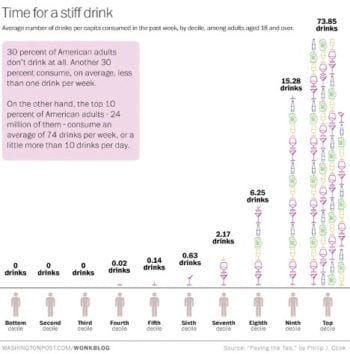USA: Big Alcohol Dependent on Heavy Users
Analysis shows how heavily dependent the alcohol industry is on heavy alcohol users. If the top 10% of alcohol consumers would be induced to curb their consumption level – for example through alcohol taxation and other price policy measures – to that of the next lower group (the ninth decile), the total alcohol sales would fall by 60%.
The top 10% of alcohol users in the United States – 24 million adults over age 18 – consume, on average, 74 alcoholic drinks per week. It means an alcohol intake of 10 drinks per day. For one week that equals the consumption of more than four-and-a-half 750 ml bottles of Jack Daniels, 18 bottles of wine, or three 24-can cases of beer.
I agree that it’s hard to imagine consuming 10 drinks a day,” said Philip J. Cook, author of “Paying the Tab,” as per Washington Post. told me.
… there are a remarkable number of people who drink a couple of six packs a day, or a pint of whiskey.”
The top 10% of alcohol users in the United States account for more than 50% of the alcohol consumed in any given year.
30% of the American population live free from any alcohol consumption. And another 30% consume less than one alcoholic drink per week, on average.
Pervasive alcohol harm
In Paying the Tab, Cook outlines pervasive alcohol harm in the United Stated, resulting not only in driving under the influence of alcohol, premature deaths or addiction, but also family suffering, crime, violence, poverty, poor health, and squandered human potential.
Young and old, alcohol users and abstainers alike, all are affected. Every American is paying for alcohol abuse. Paying the Tab, the first comprehensive analysis of this complex policy issue, calls for broadening our approach to curbing destructive [alcohol use].”

Source: Christopher Ingraham, Wonk Blog, Washington Post, September 25, 2014
In his Washington Post article, Ingraham points out that the shape of this usage curve was not unique.
The Pareto Law states that “the top 20% of buyers for most any consumer product account for fully 80% of sales.” The rule can be applied to everything from hair care products to X-Boxes.
But the consequences of the Pareto Law were different with regard to industries like alcohol and tobacco. Consumption of 10+ alcoholic drinks a day, for example, meant almost certainly having an alcohol use disorder.
But clearly Big Alcohol is heavily dependent on these types of consumers for their profits.
One consequence is that the heaviest [alcohol users] are of greatly disproportionate importance to the sales and profitability of the alcoholic-beverage industry,” Cook writes, as per Ingraham.